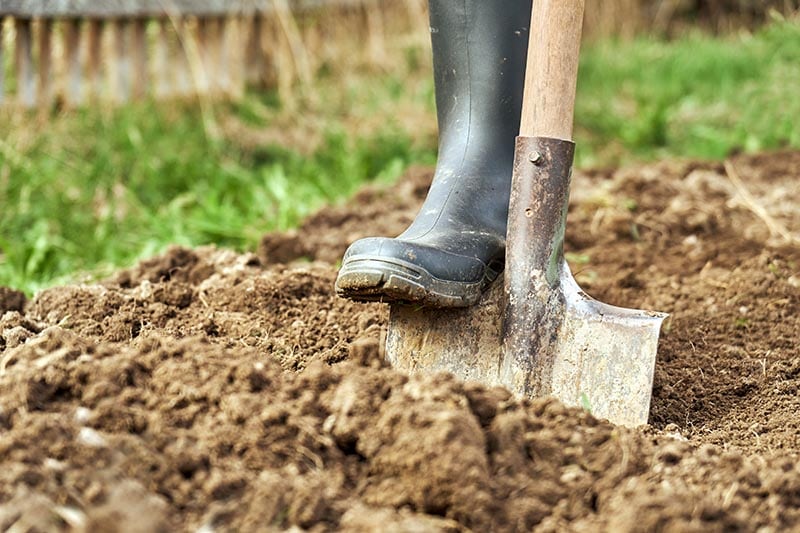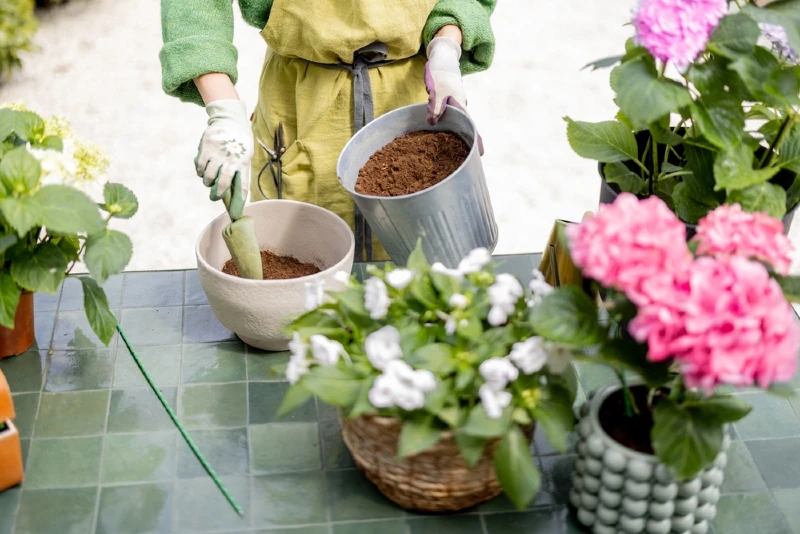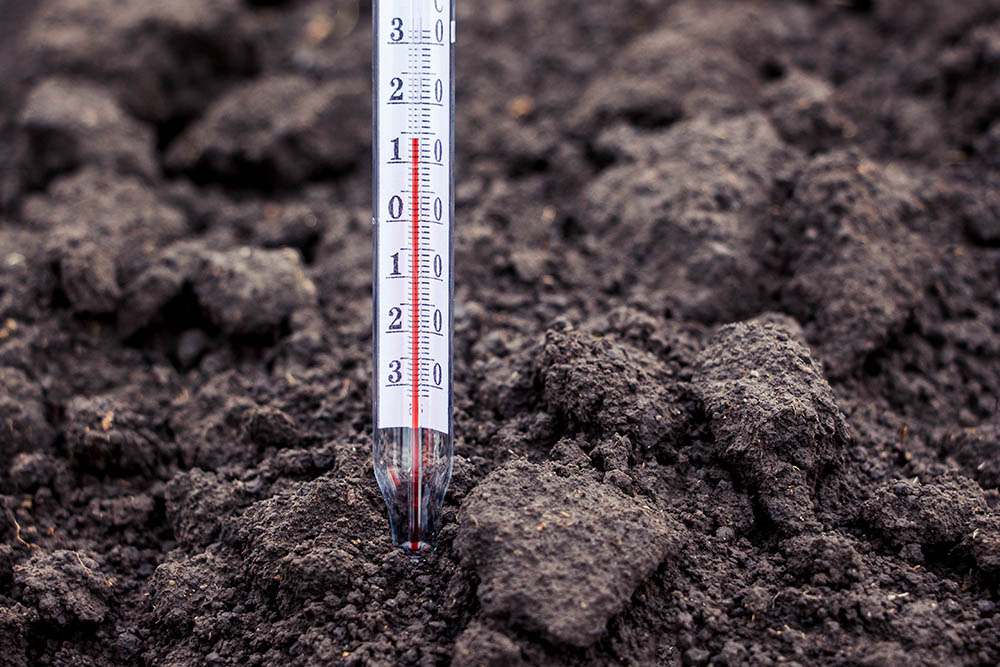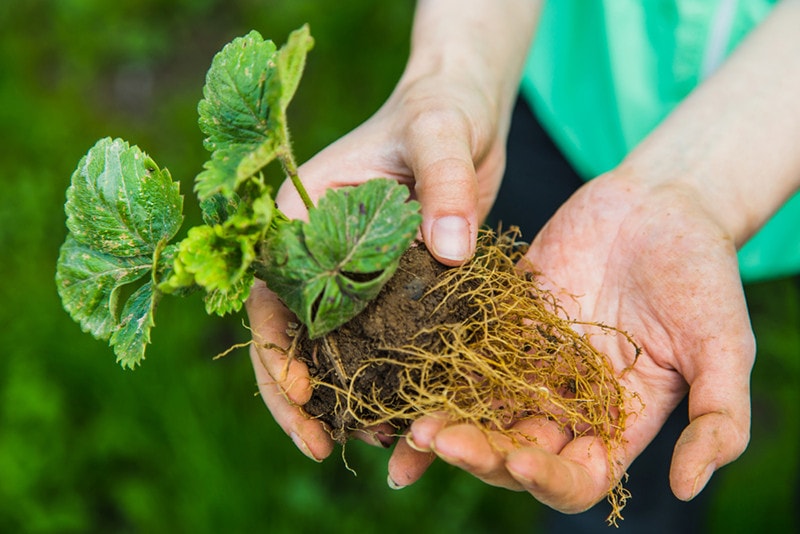How to Plant Bare Root Trees (Helpful Planting Guide & 6 Expert Tips)
-
Pete Ortiz
- Last updated:

Most people purchase bare root trees and shrubs to take advantage of their cost-effectiveness. They are easy to order (from mail catalogs) and plant. However, when the plants are delivered, most people never know the necessary steps required to ensure the plants grow and thrive.
Planting bare root trees differs from planting trees that come in pots or with their roots wrapped in burlap. The process may sound technical, but it is easy if you have prior information about the proper way of planting them.
In this article, we will offer you some expert tips so that you can help your trees get off with the best start in life.
In this article we will cover the following:
What Are Bare Root Plants?
Essentially, bare root trees are dormant perennial plants that have been harvested and stored without any soil in their roots. These plants are dug up when they are not actively growing and then refrigerated until they can be shipped to customers.
Growing trees from bare roots work well for various vines, shrubs, trees, and other perennials. Bare root plants you can expect to order are fruit trees, strawberries, roses, ornamental trees and shrubs, raspberries, asparagus, etc.
Bare root trees require specialized care once delivered. They may look bland when you unwrap them because of their slender form. Nevertheless, once they start growing, you will definitely appreciate how robust they can grow. The ideal time to plant bare roots is from November to March when they are still dormant. If the planting conditions are not suitable when the tree is delivered, you may have to wait until the ideal moment to plant.
Before You Start: 4 Pre-Planting Care Steps
1. Unpack Your Bare Root Trees
Immediately the plants are delivered, ensure that you unwrap them. First, remove all the materials used for wrapping, then remove the tree from the box. The wrapping material used depends on the exact type of tree that you have purchased. The roots may be wrapped in a cloth, while others are simply put in a shopping bag. However, do not remove the root cover until you are ready to plant.

2. Keep the Tree Hydrated
If you want your bare root trees to grow and thrive, never allow your roots to get dry. So, do not leave them lying on the ground with their roots exposed, not even for a short while. Exposure to the wind will quickly dehydrate the roots and cause irreparable damage. There are two options you can utilize to prevent the roots from drying. However, the option you use will depend on your planting schedule.
- Insert the roots in water. If you intend to plant the bare roots in the next 24 hours, simply put the roots in water. You can use any type of container, provided it is big enough to hold the roots. Just remove the wrapping on the roots and put them in the water while ensuring the roots are completely submerged. Part of the stem can also get below the water level, which is okay. You can leave the trees in the water until you are ready to plant.
- Put the trees in a shallow hole. If you do not intend to plant your trees after they are delivered, you can simply dig a hole in your yard and lay them at an angle. You can also water them and then add enough soil in the hole, enough to cover the roots. You can leave the trees in the hole for days or even weeks if necessary, until you are ready to plant. Just make sure they do not sprout too much.
3. Choosing a Planting Location
Once the tree has been planted, it is not wise to move it again. Therefore, decide the best permanent position to plant your bare root tree. You have to consider the tree’s sunlight or shading requirements to get an ideal spot in your yard. Also, consider how wide the tree could get and allocate a spot with enough space for expansion. Ideally, plant your trees away from buildings, walls, and fences.
If you plant the tree next to your property line, your neighbor has a legal right to trim it back to the property line, which may destroy the tree’s shape. Therefore, it is best to plant the trees inside your property line to control how the plant grows and the shape it takes.
4. Planting Site Preparation

The success of bare root trees depends on how well you prepare your potting mix or soil. You can use whatever type of soil in your backyard. Experts discourage planting trees with store-bought soil. If the soil in your yard is poor, you can use more organic material.
Find a large area with loose soil so that the young roots of the plants can penetrate and absorb nutrients to establish more quickly. The area should be at least three times the pot’s diameter and needs to be as deep as your spade can get.
As you dig, keep adding organic material. You can use any type of organic material1, but the best is rotted sheep, horse, or cow manure if you can get some. Alternatively, you can use garden compost, peat moss, or topsoil from a garden center.
Ensure to uproot out any weeds near the planting area and remove any stones bigger than your fists. You can remove smaller stones too, but it is not ideal because they can help with drainage. Finally, turn over the soil to mix the organic matter with the soil, then level it out as you get ready to plant your bare roots.
How to Plant Bare Root Trees in the Ground
It’s crucial to follow proper planting techniques1, including making a hole large enough to accommodate the roots and adding organic matter to the soil to help the tree establish itself.
1. Preparing Your Bare Roots
If you had initially left your tree in a container with water, then your tree is ready to go. If you had placed the bare roots in the soil, carefully dig the plant out and put it in a container with water the night before you want to plant. You can also put the plant in the water a few hours before planting. If the roots were bound with a string, you should also remove them.
2. Dig a Hole

The size of the hole depends on the root size. It should be wide enough to accommodate them without bending or breaking. Make it twice the root’s diameter with a depth equal to the depth of the tree’s roots. Loosen the soil at the bottom of the hole to allow the roots to spread out and establish themselves. If your bare root plants are for a screen, windbreak, or hedge, digging a trench is better so that positioning the plant is easier.
3. Stake Your Tree
Bare root trees require support before the root system is established enough to get stable. The best way to provide the required support is to stake them. The stake you use should be strong enough to push into the ground without bending. Put the stakes in the ground before planting the trees so that you do not accidentally damage the roots as you drive them in after planting.
4. Plant the Bare Root Tree

Create a small mound of soil at the center of the planting area and spread the tree roots over the mound. Place the tree in the hole in a way that the roots spread evenly and the tree stands straight. Then, tamp it down gently to remove any air pockets. Don’t add soil amendments like bark or peat. Besides, don’t apply fertilizer, chemicals, or potting soil to your new trees.
5. Shovel in the Remaining Soil
After placing the tree in the hole and filling it with soil, shovel in the remaining soil around the tree. Make sure to leave a small depression around the base of the tree to allow proper watering. Tap down the soil gently to ensure good contact between the soil and the roots. Water the tree thoroughly to settle the soil and provide moisture to the roots.
6. Spread Protective Mulch After the Water Soaks In

Spreading protective mulch1 around the tree base after the water has soaked in suppresses weeds, conserves moisture, and controls soil temperature. Ensure the mulch and soil around your bare root trees are moist and not soggy, but don’t water them too much as it can cause them to rot.
How to Plant Bare Root Trees in a Container
A bare root tree should only grow in a container for at least two years before transplanting it elsewhere.
1. Submerge the Roots in a Bowl With Water
Submerge for at least 30 minutes to rehydrate the roots and make them more pliable for planting in a container. Remove any damaged or dead roots and trim back any long or excess roots. This way, the tree establishes itself faster and makes it easier to fit in the container.
2. Use a Large Container to House the Tree’s Root System
Usually, a container at least 18 inches in diameter and 24 inches deep is sufficient for most bare-root trees. If the tree has an especially large or complex root system, use a larger container. Besides, use a container with drainage holes. It prevents the roots from getting waterlogged.
3. Add Compost to the Container & Position the Bare Root Tree Centrally

Put high-quality, well-rotted compost up around 2 to 3 inches below the rim. Then, place the bare root tree centrally. Ensure the root system is straight, and the bare root tree is vertical.
4. Gently Spread the Roots Out in the Compost
You can use your hands or a trowel. Make sure the roots are not crowded or twisted. Once the tree is in place, add more compost around the roots. Press it down gently to eliminate air pockets. Ensure you also leave enough room to water the bare root tree.
5. Insert a Stake Into the Compost
Ensure the stake you insert is long enough to reach the bottom of the container. Insert it at an angle parallel to the tree trunk. It helps stabilize the tree and support it as it grows.
6. Water the Tree Well

Give your bare root tree a thorough watering immediately after planting. It helps the soil settle around the roots and ensures it’s moist. Water often during dry or hot weather.
The 6 Expert Tips When Planting Bare Root Trees
1. Be Aware of Temperature

Keep bare root trees cool, about 40°F, until you plant to prevent the tree from drying and allow the roots to stay dormant. It gives them a better chance of survival once planted. If you cannot store the bare root tree in a cool place, wrap the roots in damp burlap or plastic. This way, you’ll keep them hydrated.
2. Choose Your Planting Season Carefully
Plant bare-root trees during spring when the soil temperature is warm enough for the roots to grow. It also allows the tree to establish itself before the hot summer months arrive.
3. Act Fast
It’s crucial to plant the tree as soon as possible after buying. Bare root trees can dry out fast if not planted sooner.
4. Beware of Sun Exposure

Don’t expose the roots of the bare root trees to the sun. It can make the roots dry out and, in turn, make it more challenging to establish itself and thrive.
5. Maintain Proper Water Care
Before planting, hydrate the roots of the bare-root tree for 1–2 hours in a tank of water. Check for damaged or broken roots and prune them off. It’ll ensure the tree grows and establishes itself well in the new location. After you have planted the tree, add a generous amount of water into the soil, but make sure that the soil soaks it up before adding any more. Over-watering can lead to root rot, which can destroy your tree.
6. Use Mycorrhizal Fungi to Protect from Disease
Give bare-root plants a little boost. Before putting the tree into the soil, experts recommend soaking the roots in a mixture of water and mycorrhizal fungi1. This will protect the roots from diseases and help them to establish more quickly. Mycorrhizal fungi are usually sold in granules or powder packets. You can either mix them with water and dunk the roots before planting or sprinkle them directly on the soil.
What Are the Benefits of Planting Bare Root Trees?
- They’re cost-effective. Bare root trees are 50% less costly when compared to the potted varieties. They are cheaper because the labor required to plant the plants is delegated to the consumers. Additionally, since they do not have the heavy soil ball, they are not as heavy as potted plants, which makes them easy to transport to consumers. Their minimal space requirement and reduced weight significantly reduce the shipping costs, which allows the buyers to save money.
- They’re less prone to transplant shock. Transplant shock1 occurs when a tree is damaged during the transplanting process and struggles to establish itself in its new environment. Bare root trees have less soil surrounding their roots and a smaller root system. They’re less likely to get damaged during the transplanting process.
- Bare root trees have a higher chance of surviving. Bare root trees have a smaller root system. That means they require less water and nutrients to establish themselves. The roots establish fast. It also makes them easier to plant and less prone to stress.
- No need for plastic pots, thus eco-friendly. Planting bare root trees is an eco-friendly option as it eliminates the need for plastic pots, which are not biodegradable or reusable. Bare root trees are grown and sold with their roots exposed. You can plant them directly into the ground without a plastic pot. It reduces the environmental impact of planting trees.
- More healthy roots. Unlike balled and bur lapped (B&B) or container trees, whose root system is usually hidden in the soil/root ball, the root system of bare root trees is usually visible. This is an advantage because you can assess whether the roots are healthy. You can also tell whether they are girdled and how extensive the root system is. Generally, bare roots have more mass when compared to (B&B) and container trees by 200%.
In Conclusion
Many people tend to shy away from bare-root trees because of the technicalities involved in planting them. However, these trees have several distinct advantages over their potted counterparts. For starters, they are cheap and easy to order, and if you follow the proper planting techniques, your new trees will flourish and improve the aesthetic appeal of your yard.
To make sure your bare root trees grow and thrive, make sure that you insert them in a container with water immediately after you unwrap them, that is if you intend to plant them in the next 24 hours. If you have not determined an appropriate planting time, you can dig a shallow hole in your yard and cover it with a mixture of soil and organic matter until you are ready to plant.
When planting the trees, ensure the area you intend to plant is well-prepared and is far from buildings and fences. Drive a stake into the ground next to the tree roots, and then insert your plant while ensuring that the soil levels are at the line where the color changes on the tree trunk. After planting, make sure you regularly water your plants so that the roots can be established more quickly.
- http://gardeningknowhow.com/
- http://www.ecotreecare.co.uk/mycorrhizal-inoculation.htm
- http://websoilsurvey.sc.egov.usda.gov/App/HomePage.htm
- https://www.gardeningknowhow.com/garden-how-to/soil-fertilizers/peat-moss-information.htm
- https://blogs.ifas.ufl.edu/polkco/2018/05/21/proper-planting-techniques-for-perennials-and-annual-bedding-plants/
- https://infonet-biovision.org/PlantHealth/Mulching
- https://www.extension.purdue.edu/extmedia/bp/bp-31.html#:~:text=Transplant%20shock%20is%20a%20term,poorly%20established%20in%20the%20landscape.
- https://hortnews.extension.iastate.edu/faq/what-proper-way-plant-bare-root-tree#:~:text=When%20ready%20to%20plant%2C%20dig,as%20it%20meets%20the%20roots.)
- https://extension.sdstate.edu/planting-bare-root-trees
Featured Image Credit: Dmitriev Mikhail, Shutterstock
Contents


